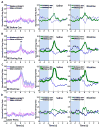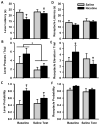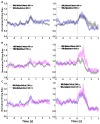Orbitofrontal participation in sign- and goal-tracking conditioned responses: Effects of nicotine
- PMID: 28012948
- PMCID: PMC5385154
- DOI: 10.1016/j.neuropharm.2016.12.020
Orbitofrontal participation in sign- and goal-tracking conditioned responses: Effects of nicotine
Abstract
Pavlovian conditioned stimuli can acquire incentive motivational properties, and this phenomenon can be measured in animals using Pavlovian conditioned approach behavior. Drugs of abuse can influence the expression of this behavior, and nicotine in particular exhibits incentive amplifying effects. Both conditioned approach behavior and drug abuse rely on overlapping corticolimbic circuitry. We hypothesize that the orbitofrontal cortex (OFC) regulates conditioned approach, and that one site of nicotine action is in the OFC where it reduces cortical output. To test this, we repeatedly exposed rats to 0.4 mg/kg nicotine (s.c.) during training and then pharmacologically inactivated the lateral OFC or performed in vivo electrophysiological recordings of lateral OFC neurons in the presence or absence of nicotine. In Experiment 1, animals were trained in a Pavlovian conditioning paradigm and behavior was evaluated after inactivation of the OFC by microinfusion of the GABA agonists baclofen and muscimol. In Experiment 2, we monitored phasic firing of OFC neurons during Pavlovian conditioning sessions. Nicotine reliably enhanced conditioned responding to the conditioned cue, and inactivation of the OFC reduced conditioned responding, especially the sign-tracking response. OFC neurons exhibited phasic excitations to cue presentation and during goal tracking, and nicotine acutely blunted this phasic neuronal firing. When nicotine was withheld, both conditioned responding and phasic firing in the OFC returned to the level of controls. These results suggest that the OFC is recruited for the expression of conditioned responses, and that nicotine acutely influences this behavior by reducing phasic firing in the OFC.
Keywords: Electrophysiology; Goal tracking; Inactivation; Nicotine; Orbitofrontal cortex; Rats; Sign tracking.
Copyright © 2016 Elsevier Ltd. All rights reserved.
Conflict of interest statement
Notes: The authors declare no competing financial interest.
Figures









Similar articles
-
Nicotine-enhanced Pavlovian conditioned approach is resistant to omission of expected outcome.Behav Brain Res. 2018 May 2;343:16-20. doi: 10.1016/j.bbr.2018.01.023. Epub 2018 Feb 3. Behav Brain Res. 2018. PMID: 29407412 Free PMC article.
-
Orbitofrontal inactivation impairs reversal of Pavlovian learning by interfering with 'disinhibition' of responding for previously unrewarded cues.Eur J Neurosci. 2009 Nov;30(10):1941-6. doi: 10.1111/j.1460-9568.2009.06992.x. Epub 2009 Nov 11. Eur J Neurosci. 2009. PMID: 19912335 Free PMC article.
-
The tendency to sign-track predicts cue-induced reinstatement during nicotine self-administration, and is enhanced by nicotine but not ethanol.Psychopharmacology (Berl). 2016 Aug;233(15-16):2985-97. doi: 10.1007/s00213-016-4341-7. Epub 2016 Jun 9. Psychopharmacology (Berl). 2016. PMID: 27282365 Free PMC article.
-
Behavioral characteristics and neurobiological substrates shared by Pavlovian sign-tracking and drug abuse.Brain Res Rev. 2008 Jun;58(1):121-35. doi: 10.1016/j.brainresrev.2007.12.003. Epub 2007 Dec 28. Brain Res Rev. 2008. PMID: 18234349 Free PMC article. Review.
-
Critical role of peripheral sensory systems in mediating the neural effects of nicotine following its acute and repeated exposure.Rev Neurosci. 2014;25(2):207-21. doi: 10.1515/revneuro-2013-0067. Rev Neurosci. 2014. PMID: 24535300 Free PMC article. Review.
Cited by
-
Nicotine Produces a High-Approach, Low-Avoidance Phenotype in Response to Alcohol-Associated Cues in Male Rats.Alcohol Clin Exp Res. 2019 Jun;43(6):1284-1295. doi: 10.1111/acer.14043. Epub 2019 May 9. Alcohol Clin Exp Res. 2019. PMID: 30958564 Free PMC article.
-
Nicotine Enhances Goal-Tracking in Ethanol and Food Pavlovian Conditioned Approach Paradigms.Front Neurosci. 2021 Aug 18;15:561766. doi: 10.3389/fnins.2021.561766. eCollection 2021. Front Neurosci. 2021. PMID: 34483813 Free PMC article.
-
Modulation of Dopamine Neurons Alters Behavior and Event Encoding in the Nucleus Accumbens during Pavlovian Conditioning.J Neurosci. 2025 Jun 25;45(26):e0061252025. doi: 10.1523/JNEUROSCI.0061-25.2025. J Neurosci. 2025. PMID: 40393804
-
Nicotine-enhanced Pavlovian conditioned approach is resistant to omission of expected outcome.Behav Brain Res. 2018 May 2;343:16-20. doi: 10.1016/j.bbr.2018.01.023. Epub 2018 Feb 3. Behav Brain Res. 2018. PMID: 29407412 Free PMC article.
-
A proposed role for glucocorticoids in mediating dopamine-dependent cue-reward learning.Stress. 2021 Mar;24(2):154-167. doi: 10.1080/10253890.2020.1768240. Epub 2020 Jun 11. Stress. 2021. PMID: 32396486 Free PMC article.
References
Publication types
MeSH terms
Substances
Grants and funding
LinkOut - more resources
Full Text Sources
Other Literature Sources

